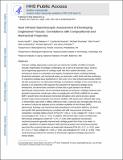Near infrared spectroscopic assessment of developing engineered tissues: correlations with compositional and mechanical properties
Author(s)
Hanifi, Arash; Palukuru, Uday; McGoverin, Cushla; Spencer, Richard G.; Pleshko, Nancy; Shockley, Michael J; Frank, Eliot Henry; Grodzinsky, Alan J; ... Show more Show less
Downloadnihms836874.pdf (2.531Mb)
OPEN_ACCESS_POLICY
Open Access Policy
Creative Commons Attribution-Noncommercial-Share Alike
Terms of use
Metadata
Show full item recordAbstract
Articular cartilage degeneration causes pain and reduces the mobility of millions of people annually. Regeneration of cartilage is challenging, due in part to its avascular nature, and thus tissue engineering approaches for cartilage repair have been studied extensively. Current techniques to assess the composition and integrity of engineered tissues, including histology, biochemical evaluation, and mechanical testing, are destructive, which limits real-time monitoring of engineered cartilage tissue development in vitro and in vivo. Near infrared spectroscopy (NIRS) has been proposed as a non-destructive technique to characterize cartilage. In the current study, we describe a non-destructive NIRS approach for assessment of engineered cartilage during development, and demonstrate correlation of these data to gold standard mid infrared spectroscopic measurements, and to mechanical properties of constructs. Cartilage constructs were generated using bovine chondrocyte culture on polyglycolic acid (PGA) scaffolds for six weeks. BMP-4 growth factor and ultrasound mechanical stimulation were used to provide a greater dynamic range of tissue properties and outcome variables. NIR spectra were collected daily using an infrared fiber optic probe in diffuse reflectance mode. Constructs were harvested after three and six weeks of culture and evaluated by the correlative modalities of mid infrared (MIR) spectroscopy, histology, and mechanical testing (equilibrium and dynamic stiffness). We found that specific NIR spectral absorbances correlated with MIR measurements of chemical composition, including relative amount of PGA (R = 0.86, p = 0.02), collagen (R = 0.88, p = 0.03), and proteoglycan (R = 0.83, p = 0.01). In addition, NIR-derived water content correlated with MIR-derived proteoglycan content (R = 0.76, p = 0.04). Both equilibrium and dynamic mechanical properties generally improved with cartilage growth from three to six weeks. In addition, significant correlations between NIRS-derived parameters and mechanical properties were found for constructs that were not treated with ultrasound (PGA (R = 0.71, p = 0.01), water (R = 0.74, p = 0.02), collagen (R = 0.69, p = 0.04), and proteoglycan (R = 0.62, p = 0.05)). These results lay the groundwork for extension to arthroscopic engineered cartilage assessment in clinical studies.
Date issued
2017-04Department
Harvard University--MIT Division of Health Sciences and Technology; Massachusetts Institute of Technology. Center for Biomedical Engineering; Massachusetts Institute of Technology. Department of Biological Engineering; Massachusetts Institute of Technology. Department of Electrical Engineering and Computer Science; Massachusetts Institute of Technology. Department of Mechanical EngineeringJournal
The Analyst
Publisher
Royal Society of Chemistry (RSC)
Citation
Hanifi, Arash, Uday Palukuru, Cushla McGoverin, Michael Shockley, Eliot Frank, Alan Grodzinsky, Richard G. Spencer, and Nancy Pleshko. “Near Infrared Spectroscopic Assessment of Developing Engineered Tissues: Correlations with Compositional and Mechanical Properties.” The Analyst 142, no. 8 (2017): 1320–1332.
Version: Author's final manuscript
ISSN
0003-2654
1364-5528